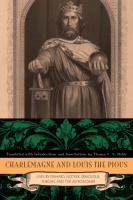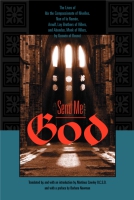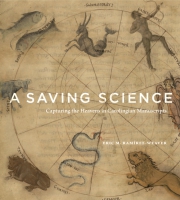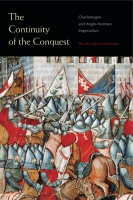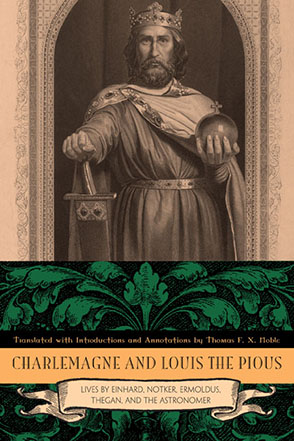
Charlemagne and Louis the Pious
Lives by Einhard, Notker, Ermoldus, Thegan, and the Astronomer
Translated, with introductions and annotations, by Thomas F. X. Noble
Charlemagne and Louis the Pious
Lives by Einhard, Notker, Ermoldus, Thegan, and the Astronomer
Translated, with introductions and annotations, by Thomas F. X. Noble
“The new translations of these five lives and their very useful introductions and notes make this work a prodigious achievement and an extremely valuable and most welcome contribution to Carolingian studies.”
- Description
- Reviews
- Bio
- Table of Contents
- Sample Chapters
- Subjects
Thomas F. X. Noble’s new English translations of these five important texts—Einhard’s Life of Emperor Charles, Notker’s Deeds of Charles the Great, Ermoldus Nigellus’s Poem in Honor of Louis, Thegan’s Deeds of Emperor Louis, and the Life of Louis by “the Astronomer”—are each accompanied by a short introduction and a note on “Essential Reading.” Offering details on matters of style, sources used by the author, and the influence, if any, exerted by the text, Noble provides a context for each translation without compromising the author’s intended voice. By “reuniting” these five essential medieval texts in an English translation, this volume makes these voices accessible to scholars and non-experts alike throughout the Anglophone world.
“The new translations of these five lives and their very useful introductions and notes make this work a prodigious achievement and an extremely valuable and most welcome contribution to Carolingian studies.”
“Noble’s book has a very specific thematic focus that makes it especially appealing for use in lower-division classes. . . . Noble has presented us with lucid translations of five important works of secular biography from the Carolingian period, each adorned with learned . . . introductions and up-to-date bibliographies.”
Thomas F. X. Noble is Professor and Chair, Department of History, at the University of Notre Dame.
Contents
Acknowledgments
Introduction
Einhard, the life of Charles the Emperor
Introduction
The Life of Charles the Emperor
Notker the stammerer, the Deeds of Emperor Charles the Great
Introduction
The Deeds of Emperor Charles the Great
Ermoldus Nigellus, in Honor of Louis
Introduction
In Honor of Louis, the Most Christian Caesar Augustus,
by Ermoldus Nigellus, an Exile
Thegan, the Deeds of Emperor Louis
Introduction
The Deeds of Emperor Louis
The Astronomer, the Life of Emperor Louis
Introduction
The Life of Emperor Louis
Index
Introduction
Carolingian history has long been a staple of teaching and research, but the numerous and impressive histories written by the Carolingians themselves are only recently coming into their own as serious subjects of investigation. To be sure, for more than two centuries scholars in many lands have scrutinized Carolingian “sources” for information about the Carolingian period. To their painstaking labors we own much of our basic picture of what happened in the eighth and ninth centuries. Nevertheless, the sources have usually been treated as great quarries from which the building blocks of narrative, documentation, and corroboration have been hewn. Until recently, with some notable exceptions, too little attention has been paid to the sources themselves in their own right and to their authors. It is also worth remarking, in a volume of English translations of Carolingian historical texts, that most of the old scholarship and much of the new exists in languages other than English. Undergraduates, beginning graduate students, and the elusive “general reader” who have no Latin are unlikely to read French, German, or Italian.
To be sure, source criticism of the solid, traditional variety can still sometimes bring important new insights. Two examples will suffice. Surely, one of the most familiar facts of Carolingian history is the famous question sent by Pippin III to Pope Zachary asking whether it was right that those in Francia who had the name of king had no power, while those who had power had not the name of king. Zachary allegedly responded that this situation contravened “order,” and soon thereafter Pippin was acclaimed as king by the Franks. Rosamond McKitterick has looked carefully at all the surviving evidence for this exchange and has come to the conclusion that it was a later invention. Although one may disagree with McKitterick’s reading of the evidence, her arguments are forceful and intriguing. Another well-known issue in Carolingian history involves Charlemagne’s famously contentious relations with Duke Tassilo of Bavaria. Matthias Becher has looked carefully at the Royal Frankish Annals, a semiofficial account begun in close association with the Carolingian court around 790, and he has concluded that the Annals were composed largely, if not exclusively, to create a justification for Charlemagne’s conquest of Tassilo’s duchy. Becher calls into question the Annals’ account of critical events of 757 and 763 that supposedly provided the basis for Charlemagne’s moves in 788. Like McKitterick, Becher interprets a key source as constructing earlier historical narratives to serve later needs.
Still, what is most impressive about current research is the way that it looks at Carolingian histories as key sites for the exploration of ideology, political thought, social ideals, educational attainments, and their emulation of classical models, to mention only some prominent areas of investigation. Scholars have looked at what sources do not say as a way of contextualizing what they do say and of gauging the intentions of authors. And if the production of historical texts has attracted sustained attention, so too has the reception of those texts. It is clear that there were courtly and aristocratic audiences for history and that, in consequence, histories were often written to advance particular arguments or to promote particular individuals. In short, while details still matter, historians are learning to appreciate the artistry and intentions of the authors who provided us with those details.
One kind of history is biography. In various forms—individual texts, collections, and panegyrics—biography flourished in antiquity. During the long centuries of late antiquity, however, a distinctive Christian form of biography, hagiography, the life of a holy man or woman, supplanted secular biography almost entirely. The gentleman bishop Sidonius Apollinaris (ca. 430–ca. 486) penned a sharp portrait of the Visigoth Theoderic II (r. 453–66), a text that may have been known to Charlemagne’s biographer Einhard, but he stopped short of a full biography in any sense of that term. Bishop Julian of Toledo (ca. 644–90) wrote a History of King Wamba (r. 672–80), but this text is patchy and episodic and was apparently unknown in the Carolingian period. Major early medieval historians such as Gregory of Tours (538/39–590), Bede (673–735), and Paul the Deacon (ca. 720–ca. 800) did not write biographies but did create many memorable portraits of individual rulers, as well as of queens, holy men and women, bishops, and monks. Their works were certainly known in the Carolingian period, and their influences can occasionally be traced. Conditions at the dawn of the ninth century portended no stunning rebirth of secular biography, but that is exactly what happened. Indeed, biography has long been recognized as one of the brightest bands in the spectrum of Carolingian historical writing. That said, it is important to realize how novel and impressive was the achievement of the authors whose works are gathered together in this volume.
This volume presents for the first time in one place the five royal/imperial biographies written in the Carolingian period. Chronologically the texts begin with Einhard’s The Life of Charles the Emperor and Ermoldus Nigellus’s poem In Honor of Louis, continue with Thegan’s Deeds of Emperor Louis and the Astronomer’s Life of Emperor Louis, and conclude with Notker’s Deeds of Emperor Charles the Great. Although Einhard is rightly credited with reviving the tradition of secular biography (meaning, on the one hand, the biography of a layman and, on the other hand, a biography that is fundamentally secular in scope and outlook), Ermoldus’s poem may have preceded Einhard’s Life by a year or so if the dates of composition offered below in the introductions to each text are accepted. Be that as it may, there is no evidence that either Einhard or Ermoldus knew or reacted to the other’s work. And Ermoldus’ poem treats only the period from the 780s to 826; Louis the Pious lived until 840.
I have not presented the texts in strict chronological order of composition. That is, I offer first Einhard and Notker on Charlemagne (748–814) and then Ermoldus, Thegan, and the Astronomer on Louis (778–840). I introduce each text briefly and with a few basic points in mind: The introductions supply essential details, insofar as they are known, about the authors themselves, along with information about the date and context of each life. In addition, the introductions offer some details on matters of style, the sources used by the authors, and the influence, if any, exerted by the texts. Finally, I suggest some themes and issues in each text that deserve the reader’s attention. I have tried hard not to say so much about each text that I would overdetermine the reader’s experience.
Each introduction concludes with a list of “Essential Reading.” In some cases I have cited almost everything there is on a particular author and text. In other cases, most notably Einhard, I have made choices. The reader will notice that much of the scholarship is not in English. Accordingly, my introductions attempt to synthesize for nonspecialist readers the best current thinking on the various texts. I have been reading, thinking about, and teaching these texts for many years, and each introduction contains some of my own ideas. The reading lists also point out “Collateral Sources.” Here I supply references to relevant contemporary texts in English translation. I hope that these lists will spur student reading and research and that medievalists who do not specialize in the Carolingian period will find them helpful.
I shall confine myself to just a few words on the translations. Any translation is at once an interpretation and a betrayal of an author’s work. I have tried to be as literal as possible in rendering these ninth-century Latin texts into twenty-first-century English. In four cases I have endeavored to give the reader a “feel” for the original version. For example, I hope that readers of this volume will be able to perceive the difference between Einhard’s classicizing Latin and Thegan’s biblical, annalistic style. The Astronomer and Notker were both good Latinists and could write in flowing periods. That is, they could write in what someone not schooled in Latin would consider very long, looping sentences. Occasionally, I have rendered these long sentences as they stand in the original. In many cases, however, I have broken up these sentences into two or three manageable English ones. In quite a few cases I have silently turned pronouns into proper names because Latin syntax provides clear signals that are lost in English. I have standardized the spelling of personal and place-names within each text and across all the texts.
I suppose that every translator allows himself the hope that his version is better than the existing ones. For there are many existing versions, particularly of Einhard. I am confident that my version of Einhard is better than Lewis Thorpe’s and at least as good as any of the other existing versions, with the possible exception of Paul Dutton’s—the one I would use had I not been using my own for some years. I believe that I have improved on the J. R. Ginsburg and Donna Lee Boutelle translation of Thegan and on Allen Cabaniss’s often paraphrased rendering of the Astronomer. These are the only translations into English known to me of these two works. My Notker, I think, is once again better than the familiar version of Lewis Thorpe. Other versions of Notker have not been in print in recent years, although there is a version on the Internet that I find to be rather clumsy and archaizing. My translation of Ermoldus is, I believe, the first in English to appear in print. But mine is not the first English translation of Ermoldus. The first one constituted one part of a Berkeley doctoral dissertation, and the second, part of the dissertation of my former student Carey Delores Fleiner. Fleiner’s version has many fine qualities, but in the end I decided to prepare my own. I have betrayed Ermoldus badly, however, by turning his verse into prose. In the end, I make only two claims for this volume: completeness, in that all the texts are here together, and consistency, in that one translator tackled them all.
Just one or two words are called for on the annotations to each text. First and foremost, I have not prepared these notes for specialists. That is, I have not provided running historical commentaries to each text. What have I done? I have identified all people not sufficiently identified in the texts themselves. I have explained technical terms and phrases with which a nonspecialist might reasonably be expected to be unfamiliar (my students have been especially helpful in this regard). I have occasionally clarified historical points that the texts left murky. Finally, I have supplied reasonably full cross-references between the five texts.
One last word on references: In the notes to the introductions, the reader will find both complete and abbreviated references. The abbreviated references are to works included in the list of “Essential Reading” for each introduction, where the reader will find complete bibliographic information. All other references are given full documentation in the notes themselves.
© 2009 Penn State University
Mailing List
Subscribe to our mailing list and be notified about new titles, journals and catalogs.
